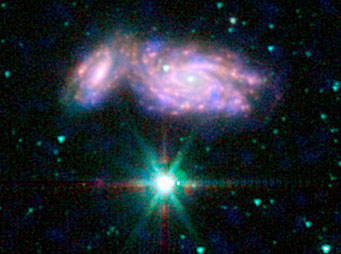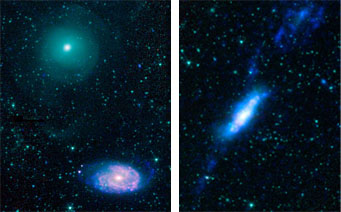It’s a pity we won’t be around when the Milky Way crashes into the Andromeda Galaxy five billion years from now. But if we were to catch the action, here’s what the smashup might look like. The simulation of the two colliding galaxies was created by Patrik Jonsson, Greg Novak and Joel Primack from the University of California, Santa Cruz. It got a semifinalist award at the 2008 NSF Science & Engineering Visualization Challenge.
Each spiral will sweep around the other, dragging out clouds of gases and dust to form prominent tidal tails. Reaching out to one another a second time, they’d trigger the formation of an intergalactic bridge. During each pass, colliding gases would spawn new stars. In the end, the combatants would collide outright, losing their separate identities and birthing a new galactic system.

Three-color image of NGC 935 and its companion IC 1801, showing far-ultraviolet emission from young stars observed by GALEX in blue, heated dust (mid-infrared emission) observed by Spitzer in red, and stellar near-infrared emission observed by Spitzer in green. The two spiral galaxies are beginning to crash into each other.
NASA / JPL-Caltech / L. Lanz (Harvard-Smithsonian CfA)
How do we know all this? By imaging other galactic pairs that are, right now in deep space, slamming into one another and creating messy crash scenes. These images are being taken with NASA’s Spitzer Space Telescope and Galaxy Evolution Explorer. GALEX’s ultraviolet views reveal concentrations of hot young stars, while Spitzer’s infrared images show clouds of warm dust in the galaxies.
Now researchers led by Lauranne Lanz (Harvard Smithsonian Center for Astrophysics) have combined the data from these telescopes to produce an atlas of galactic “train wrecks” — 50 colliding systems involving 111 galaxies.

Left: NGC 470 (top) and NGC 474 (bottom) are likely to be on their first pass past each other and are therefore relatively undisturbed at a separation of 160,000 light-years.
Right: NGC 3448 (left) and its companion UGC 6016 (right) are only separated by 75,000 light-years. UV emission shows a bridge of material between the two galaxies.
NASA / JPL-Caltech / L. Lanz (Harvard-Smithsonian CfA)
Each of these collisions takes at least a few million years to play out, making it impossible for humans to ever witness a galactic-scale smashup from start to finish. But every image in the Spitzer-GALEX compilation portrays a different phase of the collision, making it possible to get a good sense of how these gargantuan encounters might play out.
“The atlas is the first step in reading the story of how galaxies form, grow, and evolve,” said Lanz, who presented her findings at last week’s American Astronomical Society conference in Boston. Her team’s images will be used to generate computer simulations of these collisions. That’s something worth waiting for.
 6
6
Comments
Bryan
June 4, 2011 at 6:09 am
If the Big Bang is compared to the explosion of a hand grenade, I could understand that given enough time the coalesced "shrapnel" or galaxies would begin to cross paths and collide with one another due to gravity. My question is has anyone vectored the trajectories of some galaxies and determined a possible location of where the Big Bang occured? just asking
You must be logged in to post a comment.
Quadry
June 4, 2011 at 2:31 pm
There is no location for the BB because it was not an explosion in the sense of a grenade. That is an explosion that takes place in space and time. Therefore, it has a location. The bb, however, was the explosion of space and time. It didn't explode into anything. The two aren't the same.
You must be logged in to post a comment.
Gerrit Loedolff
June 5, 2011 at 2:24 pm
1 - Computer simulations and observations indicate that the Milky Way is very close to the centre of the universe.
2 - The big bang is a misunderstood concept and the life-line of evolutionists. Sure there was a big bang when God created earth, the stars etc, but so far all models put forward to prove the big bang you are referring to, are filled with errors.
You must be logged in to post a comment.
Edward Schaefer
June 7, 2011 at 2:49 pm
To be blunt about it, I consider this and all similar simulations to be highly inaccurate. My concern is that no bridge of material forms between these galaxies. For an example of this bridge, see http://www.nasa.gov/multimedia/imagegallery/image_feature_1086.html, which is of the core of the Antenna Galaxies. Note that the main tidal tails head off of the picture to the to and the left. The secondary tidal tails can then be seen heading downwards from the lower galaxy and to the right from the upper one. Then there is a huge bridge of gas, dust, and stars connecting the cores of these galaxies! That is not tidal. That is something else.
Another example of this bridge may be found in Stephan's Quintet. See http://apod.nasa.gov/apod/ap090911.html. The bridge is between the two colliding galaxies in the center. It is a dusty arc running from just above the core of the upper galaxy to just below the core of the lower galaxy.
So what becomes of galaxies merging with a bridge? If the colliding galaxies stay close enough long enough, I believe that the result is a highly barred spiral galaxy, like NGC 1365 as seen in http://apod.nasa.gov/apod/ap100820.html. In this scenario, material drawn into the bridge has formed a new galactic core, and the locations of the old core are at the ends of the bar/bridge. IMO, the barred galaxies them evolve into normal spirals.
I know that this is blatant speculation. However, the bridges between the galaxies are not being modeled. Until they are, I cannot take simulations like this one seriously.
You must be logged in to post a comment.
Rod
June 8, 2011 at 12:28 pm
Here is an interesting comment in the report:
"Each of these collisions takes at least a few million years to play out, making it impossible for humans to ever witness a galactic-scale smashup from start to finish."
That comment shows a big difference between the science of Galileo Galilei in astronomy and computer simulations. What is reported are interpretations of the observations, not facts.
You must be logged in to post a comment.
Marc
June 15, 2011 at 9:57 am
@ Gerrit Loedolff,
1. Which computer simulations and observations are you referring to that supposedly indicate that the Milky Way is very close to the centre of the universe? Any links to refereed papers? Or is this just a blanket statement based on suggestion rather than scientific concensus? Or do the models and observations date back to a time when people believed the earth was at the centre of the solar system?
2. Which errors? Specifically? Or do you base your statement on divine revelation(s)? Perhaps your divine authority would be so generous as to disclose his/her theory for the formation of the Universe. One that is supported by the laws of physics and observations and experiments? Until we find a theory that better explains the formation of the universe, I suggest that we stick with the best model currently available: an inflationary big bang.
Marc
You must be logged in to post a comment.
You must be logged in to post a comment.